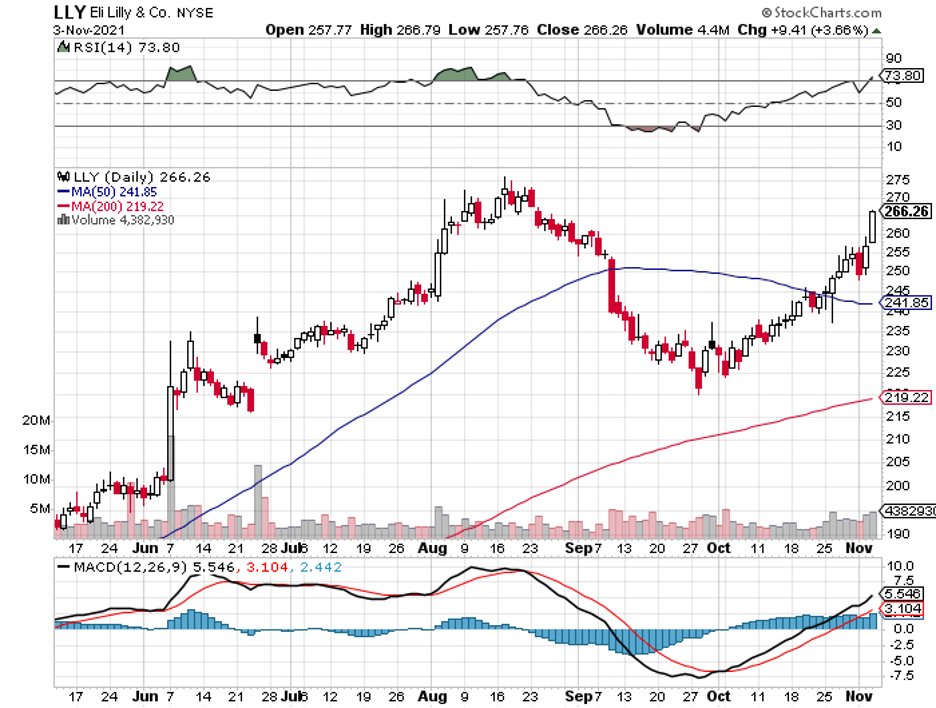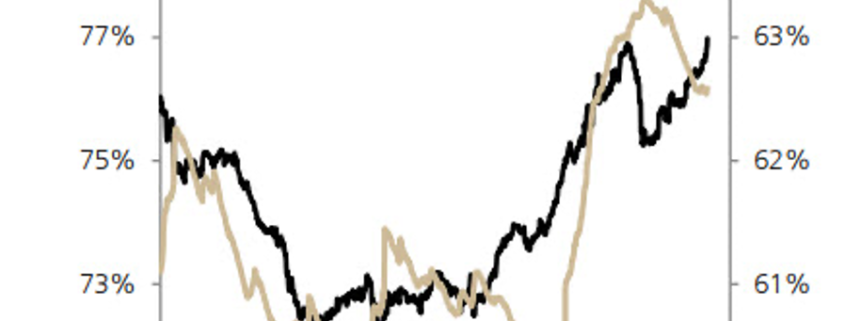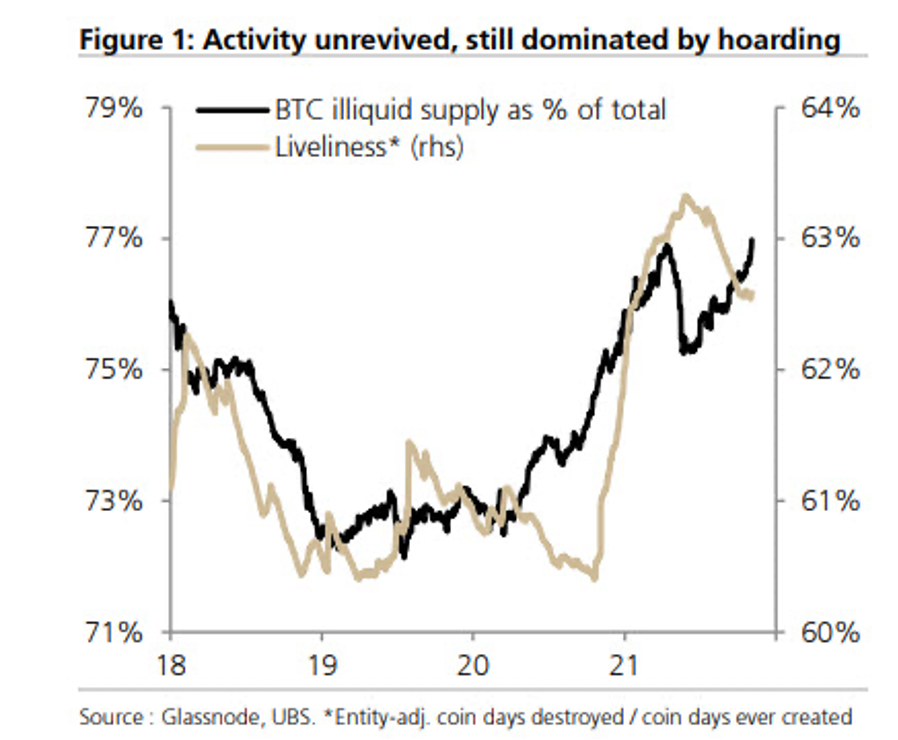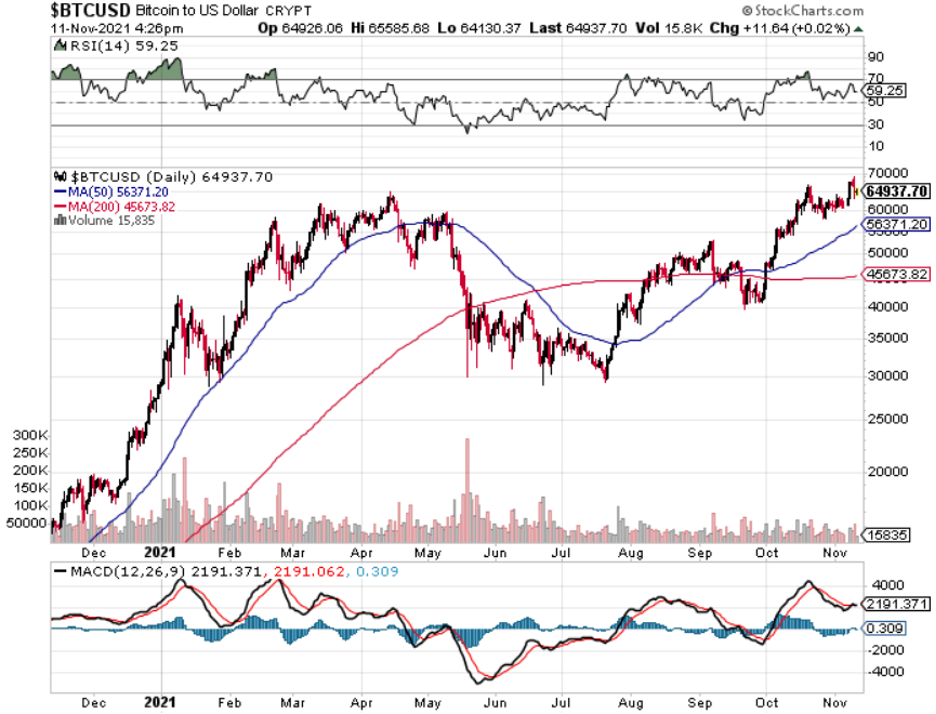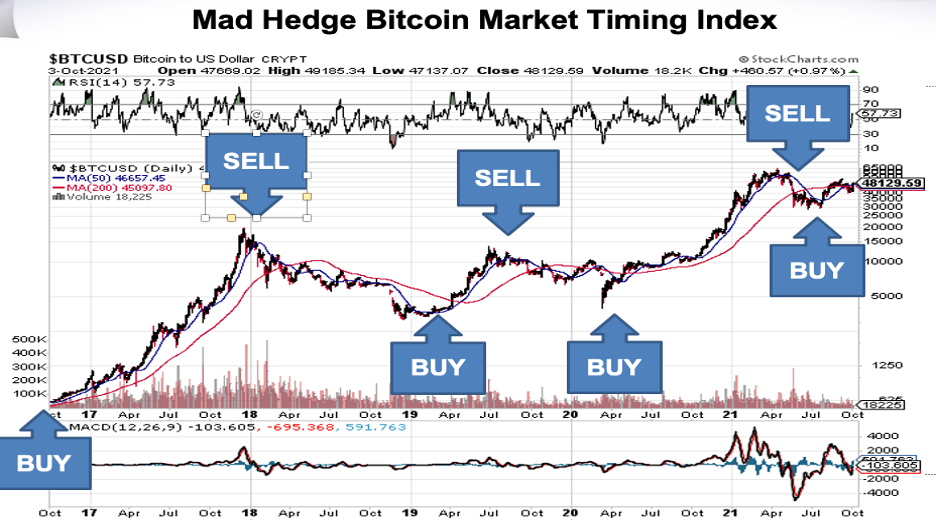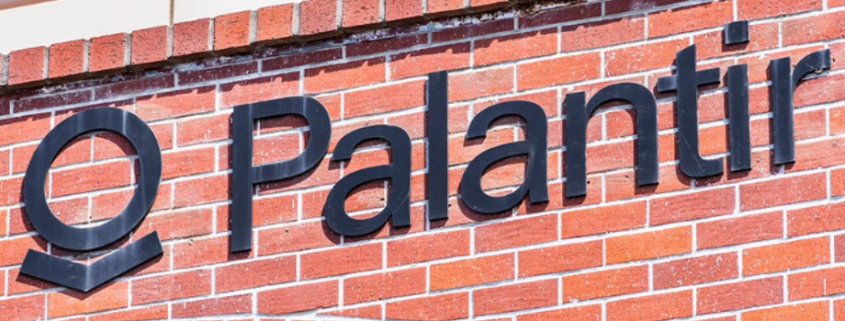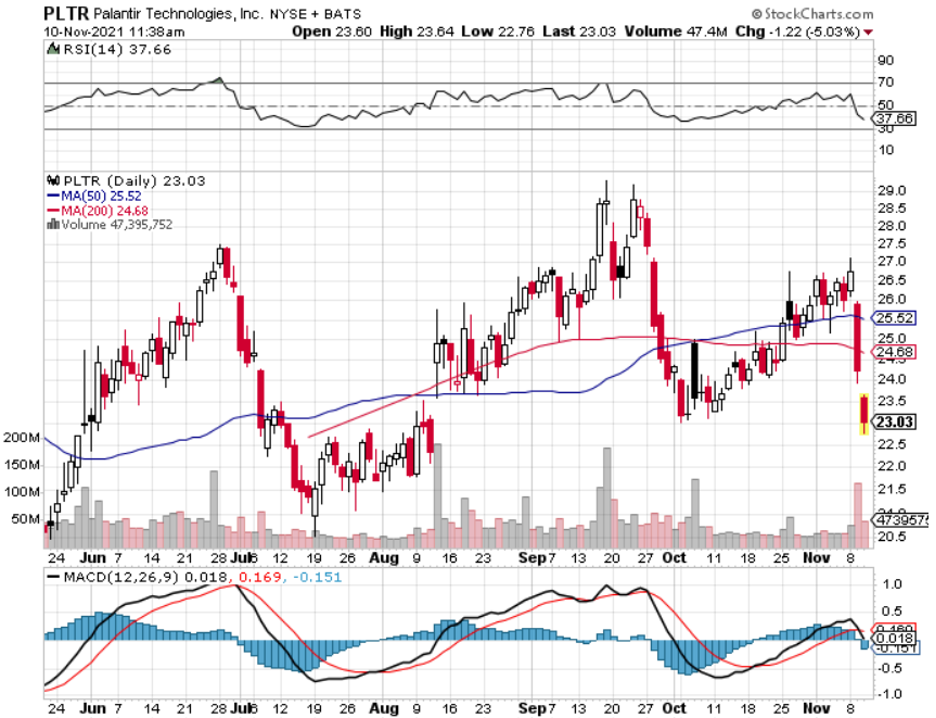“I know that you must be passionate, unreasonable, and a little bit crazy to follow your own ideas and do things differently.” – Said CEO and Founder of Salesforce Marc Benioff
Global Market Comments
November 12, 2021
Fiat Lux
Featured Trade:
(HOW TO RELIABLY PICK A WINNING OPTIONS TRADE)
Mad Hedge Biotech and Healthcare Letter
November 11, 2021
Fiat Lux
Featured Trade:
(A HIGH-QUALITY DIVIDEND STOCK WITH MORE ROOM TO GROW)
(LLY), (INCY), (GILD), (ABBV), (PFE), (NVO), (BIIB)
Investors can enjoy long-term recurring income and stability with dividend stocks. However, paying out dividends is largely discretionary.
Each business frequently determines whether it’s in a good position to hand out part of its profits to shareholders.
One method to assess a dividend’s safety is reviewing a company’s history and whether it makes regular payouts. The longer its track record shows a consistent payment, the more preferable the business.
There’s a stock particularly known for paying dividends every year for over a century in the biotechnology and healthcare sector: Eli Lilly (LLY).
While Eli Lilly’s dividend yield is only 1.5% at its current share price, which is a bit over the S&P 500’s average reported at less than 1.3%, the company has been paying out dividends since 1885.
Apart from its consistent payouts throughout the years, Eli Lilly also holds promising potential for future hikes.
At the moment, the quarterly payout of Eli Lilly is $0.85, which is 75% higher than its 2015 payout of $0.49.
This number can still climb thanks to its robust revenue growth of 19.2% year over year, with its current approved drug portfolio generating $13.55 billion in the first six months of 2021.
In the first two quarters of the year alone, several products recorded year-over-year sales growth of over 20%.
Eli Lilly isn’t content in growing its dividend, though. It’s also working on expanding its drug portfolio.
Among its existing drugs, the company has been maximizing Olumiant to include more indications.
One of the recent advancements involving Olumiant is Eli Lilly’s work with Incyte (INCY), which utilizes the drug as a treatment for COVID-19 patients.
In fact, the FDA has recently approved the use of Olumiant with or without the need to combine it with Gilead Sciences (GILD) Remdesivir.
However, Olumiant’s application as a COVID-19 treatment isn’t the most promising expansion for this drug.
Just recently, Eli Lilly and Incyte disclosed that Olumiant could be used as a treatment for an autoimmune disorder more commonly known as alopecia areata—an indication that could very well transform the drug into the company’s next blockbuster.
In a nutshell, Olumiant can help alopecia patients regrow their hair at a more rapid speed and consistent rate than other competitors.
So far, the drug has recorded an 80% hair growth among those who tested it.
In the previous months, the FDA included Olumiant and AbbVie’s (ABBV) Rinvoq in the list of JAK inhibitors that needed to carry a warning label sharing their severe potential side effects like blood clots and even cancer.
Despite this, Eli Lilly’s product proved to be safe for alopecia patients.
If approved for alopecia, Olumiant could become a groundbreaking treatment sought after by roughly 147 million people across the globe who suffer from the condition.
For context, the global market for alopecia is projected to grow in revenue from $ 7.6 billion in 2020 to reach over $ 14.2 billion by 2028 annually.
Alopecia areata, which is the target market of Eli Lilly, is expected to hold about 35% of the total. This puts the addressable market for Olumiant at $5 billion by 2028.
Considering that another name has been working to dominate the market, Pfizer’s (PFE) Cibingo, we can realistically assume that Eli Lilly will get at least 15% of the market share worldwide.
This would mean roughly $750 million in yearly revenue for Olumiant’s alopecia market alone.
Other than its work on alopecia areata, Eli Lilly has another potential blockbuster. This time, the treatment is targeting the diabetes sector.
The company has an up-and-coming treatment called Tirzepatide, which could not only expand Eli Lilly’s diabetes market share but also provide a strong competitor against Novo Nordisk’s (NVO) top-selling Ozempic.
Tirzepatide is the successor of Eli Lilly’s bestseller Trulicity, which logged $2.99 billion in the first half of 2021 and is set to lose patent protection by 2027.
Looking at Tirzepatide’s trajectory, the drug is projected to reach peak annual sales worth $10 billion—an amount that could easily offset the gradual decline in sales by Trulicity.
Even the company’s breast cancer drug, Verzenio, is set to show off impressive growth soon. In the first half of 2021, the treatment raked in $610 million in sales, demonstrating a 53.8% increase year-over-year.
Considering Eli Lilly’s efforts to distinguish its breast cancer treatment from Pfizer’s Ibrance, Verzenio is anticipated to generate $4.6 billion in annual sales by 2024.
Another exciting development is Eli Lilly’s Alzheimer’s disease treatment Donanemab.
Although Phase 3 data are expected to be released in 2023, this candidate is already reported to be a superior treatment than Biogen’s (BIIB) controversial Aduhelm.
These are some of the results of Eli Lilly’s efforts to continue expanding in the diabetes area, as seen in its ramped-up R&D spending.
So far, the company boosted its research investment by 21% year-over-year to reach $3.36 billion.
While doing this isn’t exactly a guarantee of commercial success, it’s undoubtedly a solid strategy to protect and enhance its pipeline.
Overall, Eli Lilly is a high-quality stock with a verifiable and impressive history of innovation.
Given the promising lineup of approved drugs and pipeline candidates of Eli Lilly, it’s reasonable to expect roughly a 15% yearly earnings growth from the company over the next 5 years.
Mad Hedge Bitcoin Letter
November 11, 2021
Fiat Lux
Featured Trade:
(BITCOIN HOARDERS AREN’T SELLING)
(BTC), (CPI)

Bitcoin, lately, is resting and the good thing is it’s not too choppy.
It hit around $69,000 before retracing back to the mid-$60,000 levels and it’s just the sign of things to come.
We are at the tail end of the asset purchase program and many outsiders believe there will be an awkward transition.
That’s probably not the case.
We want it orderly which helps an inherently volatile asset like Bitcoin, and I believe that is what we will get.
The 6.2% CPI number sets the upper limit precedent and if later numbers come in at 4% or 5%, Bitcoin prices will react positively.
As the price of Bitcoin has persistently maintained its north of $60,000 status, the talking heads and diva hedge fund managers have stopped criticizing its existence.
It’s about time.
That is a massive victory and stamp of validation for the fledgling asset.
At a broader level, I believe the Fed is stuck between a rock and a hard place.
Each fork in the road gives Bitcoin a higher price and they know it and the only deal breaker is uncontrollable inflation that will trigger a run on the US dollar.
Conversely, if the Fed prints more money, that’s an unambiguous green light for higher bitcoin prices cut and dry.
The second choice assumes what the Fed has somewhat admitted, inflation is permanently transitory leading to even higher levels of inflation which erodes the faith in the abilities of the Central Bank which will send Bitcoin prices higher as well.
This “liquidity event” has become a buy the rumor and sell the news follow through with Bitcoin prices trailing off.
Many were caught off guard by the strength of the CPI number and even if Bitcoin is lower today, this high inflation data strengthens the case for Bitcoin as a perceived store-of-value asset in the long term.
Sometimes we need to move 1-step backward to go 2-steps forward.
Triggered risk aversion which was accompanied by a strong dollar and weakness across the top cryptos would not have happened with a more moderate inflation number.
The little threads of doubt that inflation would be temporary have been shredded and the market has fully absorbed that a profound paradigm shift in the global economy is underway.
Another knock-on effect is near-term economic growth forecasts are trending towards that of “stagflation” — a period of stagnant demand and high inflation.
There are a lot of moving parts here, and this does move up a wall of worry for investors and retail customers.
It becomes psychologically harder to deploy large sums of capital into an alternative investment, real estate, and other large investments in this precarious environment.
That is why we are still in the $60,000 range and haven’t broken either side of $70,000 or $50,000.
On another positive note, the supply of bitcoin on exchanges continues to dwindle, which could indicate a preference among investors to hold Bitcoin in wallets instead of making their coins available to trade on exchanges.
This dovetails quite accurately with my prognosis that the crypto market is currently in a sit-and-wait mode observing to see how things shake out.
Basically, the crypto hoarders, who own 63% of the total Bitcoin supply, aren’t selling.
This short-term consolidation in the mid-$60,000 could be short-lived as I believe once the market stomachs higher inflationary numbers and strong dollar behavior, we will be barreling right into debt ceiling talks in December triggering another leg up to the Bitcoin story.
At the main street level, retail traders representing the middle class and their case to hold Bitcoin strengthens.
Living costs are up crazy and it's broad-based.
Increases in the indexes for energy, shelter, food, used cars and trucks, and new vehicles are among the larger contributors.
The case has never been stronger for the average Joe to protect themselves by investing in crypto as a bulwark against central bank money printing.
Traders in the market for futures contracts on the Federal Reserve’s key interest rate now see a 38% chance of a rate hike in June 2022, up from 28% prior to the CPI report.
My bet is that an orderly march up in rates will decrease the rate of change in higher rates giving a pathway to higher Bitcoin prices.
Ultimately, this type of news would have meant a 20% selloff if it happened a year ago, the asset has matured so much that it’s taking the stronger dollar reaction in stride.
This is highly bullish for the price of Bitcoin signaling that it’s here to stay.
“I see Bitcoin as ultimately becoming a reserve currency for banks, playing much the same role as gold did in the early days of banking. Banks could issue digital cash with greater anonymity and lighter weight, more efficient transactions.” – Said Computer Scientist Hal Finney
Global Market Comments
November 11, 2021
Fiat Lux
SPECIAL VETERANS DAY ISSUE
Featured Trade:
(A TRIBUTE TO A TRUE VETERAN)
Mad Hedge Technology Letter
November 10, 2021
Fiat Lux
Featured Trade:
(DATA ANALYTICS AT ITS FINEST)
(PLTR)
Investors shouldn’t stress too much about the drop in Palantir stock.
It’s still a great company that is on pace to do what it promised — achieve annual revenue growth of 30% or more through 2025.
In fact, they will easily surpass those projections, and any of these mini pullbacks that we are seeing now is just a matter of not fulfilling sky-high expectations and coming in a tad below that.
I can accept that and so should you.
Why is this data analytics company so great?
It is the connective tissue that connects analytics to operational systems which leads to winner business decisions.
Such architecture offers enterprises with action APIs that allow first model and simulate, and second, orchestrate and execute complex cross-functional transactions.
As the health crisis limited visibility and indicators, many started to trust the power of Palantir’s platforms and installed the technical infrastructure, to translate that into coordinated, orchestrated actions in the operations of their business.
Credit should go to Palantir’s developers who created a secret sauce to supercharge earlier-stage companies, enabling them to deliver a central operating system for their data and to scale rapidly from day zero.
These companies, they're not just managing their data and their operations, they are wielding them to blitz, scale, and conquer at a devastating rate.
Palantir’s clients originate from a diverse set of industries and continue to partner with innovative companies across industries such as automotive, biotech, healthcare, media, and the government.
Now, they are generating major product innovation that extends the openness and flexibility of their infrastructure for developers calling it Operational APIs or OPIs for short.
This liberates the ontology to serve as a nervous system, the cardiovascular system of the enterprise as a unified action and orchestration layer.
This manifests itself in a way that inventory can be allocated, production can be scheduled, orders can be fulfilled. To accomplish these deceptively simple actions requires communication with potentially tens of source systems transactionally.
Palantir allows you to orchestrate complex cross-system decisions to win and turn market disruption into competitive glory.
For example, a large industry company is unlocking value by integrating Microsoft Power apps with the Palantir Foundry platform. This powers workflows and writing data back to external operational and transactional systems
State defense contracts have been hyper-lucrative to PLTR.
PLTR has demonstrated its usefulness in the production of the A320 of RAM pickup trucks, auto parts, PPE, and tractors. PLTR can leverage its technology so customers can do it better, faster, and cheaper.
It’s a win-win for everyone.
And the defense industrial base is seeing that it can have the same impact on the production of fighter jets, naval ships, and land vehicles.
Lastly, their dealing in healthcare is shooting through the roof with cornerstone partnerships with the NHS, MD Anderson Cancer Center, 70 academic medical centers through the NIH's N3C, the Department of Veteran Affairs, and even more regional US providers means that PLTR is helping to manage over 300 million patient lives and growing.
Complex clinical care continues to be the recipient of cutting-edge products and continued innovation.
It’s not surprising that PLTR’s US commercial revenue growth accelerated once again to 103% year over year and this flavor of business offers the longest runway for PLTR to grow.
They more than doubled their commercial customer count.
Palantir management guided us to 34% growth in government revenue during the third quarter, while this segment was up 66% in the second quarter, but I believe this is highly misunderstood.
Just the nature of working with the government, the bureaucracy, and the single entity nature of it, deals aren’t going to be flying in left and right.
There is a processional nature to working with the US government because its such a monolith.
The more salient story here is the in-roads of the commercial business which will turn into its core identity.
The commercial business will be the x-factor driving PLTR into surpassing its revenue promises, and investors will acknowledge that as commercial revenue begins to overpower the defense contracts.
Revenue for the full year is expected to be about $1.53 billion or 40% year-over-year growth which conspicuously gets over any bar that tech growth companies are expected to jump over.
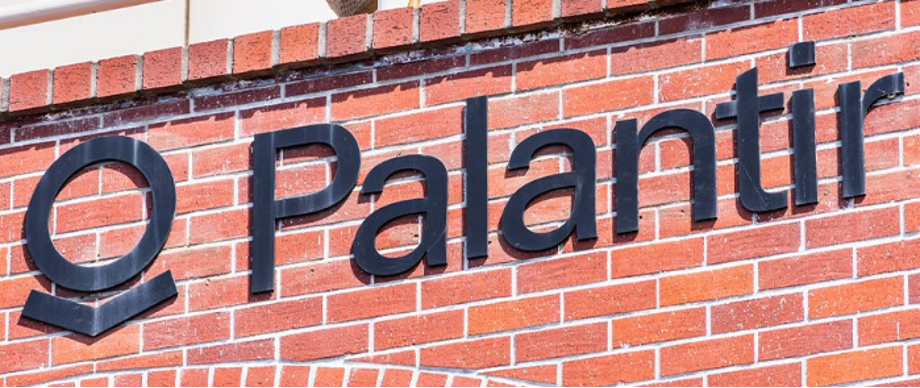
Legal Disclaimer
There is a very high degree of risk involved in trading. Past results are not indicative of future returns. MadHedgeFundTrader.com and all individuals affiliated with this site assume no responsibilities for your trading and investment results. The indicators, strategies, columns, articles and all other features are for educational purposes only and should not be construed as investment advice. Information for futures trading observations are obtained from sources believed to be reliable, but we do not warrant its completeness or accuracy, or warrant any results from the use of the information. Your use of the trading observations is entirely at your own risk and it is your sole responsibility to evaluate the accuracy, completeness and usefulness of the information. You must assess the risk of any trade with your broker and make your own independent decisions regarding any securities mentioned herein. Affiliates of MadHedgeFundTrader.com may have a position or effect transactions in the securities described herein (or options thereon) and/or otherwise employ trading strategies that may be consistent or inconsistent with the provided strategies.



